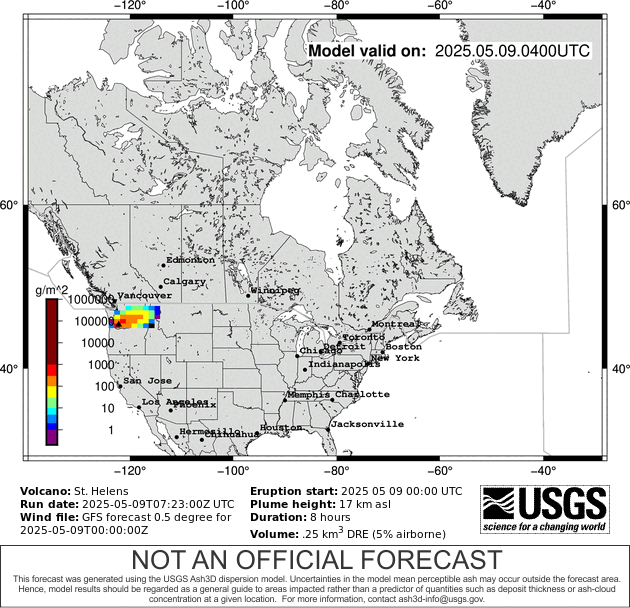By Larry Lawson and Joe Breskin

Ash from the eruption of Mount Saint Helens initially ascended into the upper atmosphere and blew easterly,but within two weeks it was observed to have returned to Western Washington.
Travelling in the jet stream, completely around the world, it begin to settle back where it had started.

In the Gulf War, about a decade later, the same wind systems took the results of bombing and burning easterly too. According to Tavassoli "the plume dropped 40,000 tons of sulfur dioxide, 3,000 tons of hydrogen sulfide, and 500,000 tons of carbon monoxide, as well as 50,000 tons of greasy soot particles over the Persian Gulf and its coastal areas. Black rain fell in the Himalayas, 2,700 km away and acid rain was recorded as far afield as China." Major rivers and aquifers in Turkey, Kuwait, Khuzastan, Southern Iran, and other regions were contaminated. According to WHO report,in Iran alone, 4 billion cubic meters of rainfall were contaminated with hazardous materials.
The soot from the fires, clearly visible in the color image below, capped the Himalayas with soot and dust and caused the normally reflective area of this huge range of mountains to absorb heat. However, changing the rains has had other impacts.
In April 1991, a large cyclone struck Bangladesh, with estimated winds of 160 mph and a central pressure of 898mb. At least 138,000 lives were lost as a result of record-breaking rains and flooding. The smoke was also tracked over China, which also experienced flooding.
Computer models tracked the oil fire smoke from Kuwait eastward. It is thought that salt and metallic particles put into the upper atmosphere by the intense heat of the refined oil buring in storage facilities and refineries may have seeded the clouds, causing the torrential rains in Bangladesh and China.

The release of soot and hydrocarbons from the burning oil-fields thus caused at least two significant changes in the environment: one was to change the albedo of the Himalayas and other affected mountain ranges, keeping the heat from solar radiation within our atmosphere, melting glaciers, exposing the underlying rock to absorb solar radiation, and thereby exacerbating weather pattern shifts. (Changes that now appear to be an ongoing process.) The changes are clearly visible from space: during the past decade almost 67 per cent of the glaciers in the Himalayan and Tienshan mountain ranges have retreated.
The other impact was the flooding of the great rivers, which were fed by this, the world's largest watershed. Scientists monitoring conditions in the Himalayas found that 'glacial lake outburst floods' are now an annual event, whereas in the past they occurred only once every 500 years. "In terms of geological time scale, this is a crisis," says Surendra Shrestha,regional coordinator in Asia for UNEP's Division of Early Warning and Assessment.
The normal cooling and moisture releasing cycles were upset. We live in a nearly closed atmospheric system, what happens in one area often effects the entire world. Dust disturbances, and the resulting effects from the recent bombing in Afghanistan may be noticeable already.
Information assembled between January and March 2003

Impact of climate change in Asia*
R. RAMACHANDRAN
Almost 67 per cent of the glaciers in the Himalayan and Tienshan mountain ranges have retreated in the past decade. * From the Chapter on Asia in the Special Report of the Inter-governmental Panel on Climate Change (IPCC) "The Regional Impacts of Climate Change: An Assessment of Vulnerability", February 2001.
Inventory of Glaciers, Glacial Lakes, Outburst Floods, Monitoring & Early Warning Systems in the Hindu Kush-Hymalayan Region, Bhutan 2002 International Centre for Integrated Mountain Development (ICIMOD) and United Nations Environment Programme (UNEP RRC.AP)
Researchers Find Genetic Response to Global Warming: Changing Climate Prompts Genetic Change in Squirrels
http://www.ualberta.ca/~publicas/folio/40/12/front.html Genetic and Plastic Responses of a Northern Mammal to Climate Change
http://www.pubs.royalsoc.ac.uk/proc_bio/abstracts/reale.html
University of Alberta biologist Stan Boutin and his research team have recently published findings that North American red squirrels exhibit genetic changes in response to a warming climate. The first Web site listed above contains a University of Alberta press release detailing this first-ever demonstration of genetic adaptation to global warming. The second Web site, from the Proceedings of the Royal Society, provides the abstract for this recently published research (full-text available only with paid subscription). With implications that extend far beyond the immediate research concerns of geneticists and environmental scientists, Boutin's work as presented in these Web sites should be interesting to wide audience. This site is also reviewed in the March 21, 2003 _NSDL Life Sciences Report_.[RS]
Indian Cyclone Fact Sheetcompiled by Julian Heming with information obtained from the Joint Typhoon Warning Center, Hawaii.
The eruptive column fluctuated in height through the day, but the eruption subsided by late afternoon on May 18. By early May 19, the eruption had stopped. By that time, the ash cloud had spread to the central United States. Two days later, even though the ash cloud had become more diffuse, fine ash was detected by systems used to monitor air pollution in several cities of the northeastern United States. Some of the ash drifted around the globe within about 2 weeks. After circling many more times, most of the ash settled to the Earth's surface, but some of the smallest fragments and aerosols remained suspended in the upper atmosphere for years.)
May 18, 1980 Eruption Ash Eruption and Fallout
Robert I. Tilling, Lyn Topinka, and Donald A. Swanson, 1990,
Eruptions of Mount St. Helens: Past, Present, and Future, USGS Special Interest Publication
Graphics and images modified for web, Lyn Topinka
http://www.fas.org/irp/gulf/cia/960620/index.html 062096_cia_72224_72224_01.txt Subject: ENVIRONMENTAL IMPACT OF OIL FIRE SUMMARY POLLUTION FROM THE OIL WELL FIRES NOW BURNING IN KUWAIT HAS IMPORTANT LOCAL AND REGIONAL ENVIRONMENTAL CONSEQUENCES.
Hidden Casualties: Environmental, Health and Political Consequences of the Persian Gulf War. Berkeley, CA: North Atlantic. 1994.